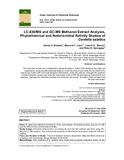LC-ESI/MS and GC-MS Methanol Extract Analysis, Phytochemical and Antimicrobial Activity Studies of Centella asiatica
Date
2020-10-07Author
Ondeko, Daniel A.
Juma, Bernard F.
Baraza, Lilechi D.
Nyongesa, Peter K.
Metadata
Show full item recordAbstract
Aims: To determine chemical constituents of the Leaf extracts of Centella asiatica using the LC-MS and GC-MS and their antimicrobial activities. Study Design: Structural determination of compounds from the leaf extracts was done using GC-MS and LC-MS analysis. The antimicrobial properties of the extracts were done using disc diffusion method. Place and Duration of Study: Pure and Applied Chemistry Department, Masinde Muliro University of Science and Technology, Kenya: Between 2016-2019. Methodology: Plant materials of C. asiatica were sequentially extracted separately based on the polarity viz., hexane, ethyl acetate and methanol. Determination of chemical constituents was done using LC-MS and GC-MS analysis and phytochemical screening. The extracts were assayed against Staphylococcus aureus, Klebsiella pneumonia, Escherichia coli and Candida albicans. Standard antimicrobials viz. ampicillin and Nystatin were used as the control. Disc diffusion method was used and zones of inhibition, after respective incubation periods, were used to quantify antibacterial and antifungal activity. Results: Phytochemical screening of the hexane, ethyl acetate and methanolic extracts showed that terpenoids, flavonoids, saponins, alkaloids, steroids, amino acids and proteins, reducing sugars and carbohydrates were present. LC-MS and GC-MS analyses of the methanolic extracts identified 22 and 33 compounds, respectively, by use of the national institute of standards and technology (NIST) library. The extracts showed appreciable activity against common microbes tested. Conclusion: This study forms the basis for the biological characterization and significance of the compounds identified in the leaf and stem extracts of C. asiatica. These compounds are known to possess antibacterial and antifungal activities that could be established as potential candidates for future drug development. However, these extracts, need to be subjected to further chromatographic procedures to isolate the identified compounds and their bioactivities determined.
URI
https://doi.org/10.9734/ajocs/2020/v8i319046https://www.journalajocs.com/index.php/AJOCS/article/view/19046
http://ir-library.mmust.ac.ke:8080/xmlui/handle/123456789/1937
Collections
- Journal Articles [411]

